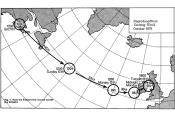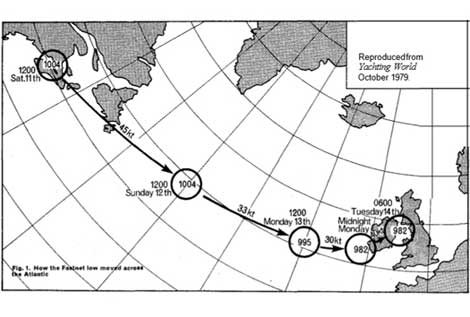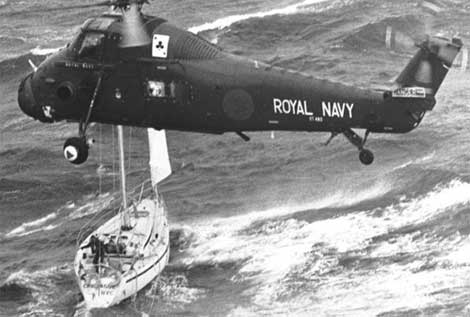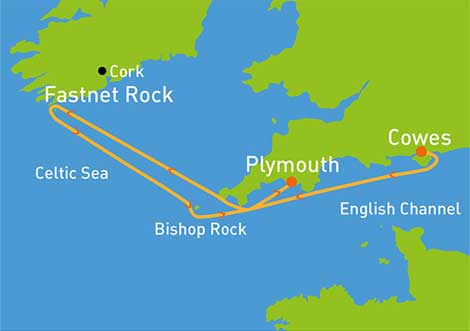1979 Fastnet Storm Force 10 and Safety At Sea

05.08.2019

How the Fastnet Low Pressure moved across The Atlantic
Great Britain has always been involved with the sea, and the Fastnet Race is a part of this tradition. In 1979 the race took place in extreme conditions causing tragic loss of life and severe pressure on rescue organisations.
In the Fastnet Race Inquiry Report, search and rescue aircraft operating in the race area on 14 August reported winds of 60 to 65 knots and a wave height of 50 to 60 feet.
1979 was the 28th Fastnet Race, it was also the climax of the international Admiral's Cup series. Held every two years, this 605 mile yachting race starts at Cowes, Isle of Wight. The course heads direct to the Fastnet Rock off southern Ireland, then passes south of the Isles of Scilly to finish at Plymouth.
The race started on Saturday 11 August. A worse than expected storm moved in from the Atlantic as the fleet was in open water between Lands End and Ireland on Monday 13 August. Force 10 winds and steep breaking seas wreaked havoc on the 303 yachts that started the race, resulting in 15 fatalities.
The report by the Institute of Oceanographic Sciences considered the effects of 40 knot southerly winds suddenly veering to westerly winds of over 50 knots. This caused fast moving waves with steep or near-vertical-sided profiles. Individual crests of the larger waves would have been travelling at speeds of 30 to 40 knots.
112 boats reported being knocked down to horizontal during the storm on one or more occasions. 77 boats reported experiencing knockdowns to substantially beyond horizontal, including total inversions and full 360° rolls. Yachts were dismasted and 12 liferafts were washed overboard.
The RNLI, HM Coastguard, Royal Navy and Irish Navy performed the largest search and rescue operation in peace-time. The bravery of lifeboat and helicopter crews is extraordinary for putting to sea and air in these conditions. Many of the missions were carried out over 60 miles from land.
Appointed jointly by the RYA and Committee of the Royal Ocean Racing Club, a Working Party was set up to consider what lessons might be learnt. New regulations were introduced for offshore racing to improve the integrity of yacht design, making VHF radios mandatory and introducing crew eligibility qualifications.
The Titanic disaster changed ship safety forever. The 1979 Fastnet Race was a seminal disaster affecting hundreds of sailors which led to major improvements for small craft design and personal safety at sea worldwide.
The 1979 Fastnet Race Inquiry Report offers a unique look at vessel design, seamanship and the anatomy of a Force 10 storm. The hard lessons learned are at the root of lifejacket, harness and liferaft designs that we use on all vessels today.
1979 Fastnet Race Inquiry Report - Royal Ocean Racing Club & RYA >
Survivors were asked to jump into the water to be rescued.
CREDIT: Royal Navy / PPL
When 303 yachts set off on the 1979 Fastnet Race there was no inkling that a storm was imminent. How did it arrive without warning, and why did it cause such mayhem?
There was nothing in the forecast at the start of the 1979 Fastnet Race to indicate a storm, but a storm came with devastating effect. How and why did it cause such a catastrophic disaster? Neither the track it followed nor the central pressure of the depression was in itself remarkable. Its speed of close to 45 knots was quick, but not exceptional. It was only when it began to slow down and deepen in the 24 hours between midday Sunday 12 August and Monday 13 that it appeared to develop storm tendencies, deepening eventually to 978mb, a central pressure that would be considered deep in winter and this was the height of summer.
By mid-afternoon on Monday, satellite pictures showed that the depression was more significant than had been thought and was deepening rapidly to a storm. It has been suggested that it was the afternoon satellite picture that prompted the imminent gale warning that unfortunately was broadcast after the shipping forecast. As the shipping forecast was the primary weather information for most yachts in those days, any warnings out side the scheduled time was unlikely to be heard at sea.
Some synoptic charts at the time indicated a trough following behind the cold front. Whether this was the front or a trough behind it, what is important is that there was a large change in wind direction in the region of 90°. This is a significant feature of the storm, with the strongest wind arriving as the pressure rapidly rose after the trough. Gusts contained within the leading edge of squalls can be half as much again (or more) as the average wind speed, making the reported gusts of 80 knots realistic.
CREDIT: Chris Tibbs - Yachting World.
1979 Fastnet Race Inquiry Report - Royal Ocean Racing Club & RYA
All images are copyright RIB & HSC 2024 unless otherwise stated.
This does not exclude the owner's assertion of copyright over the material.
23.09.2024
MCA MGN550 - Lithium-ion Batteries Guidance
Marine Guidance Note 550: 'Electrical Installations - Guidance for…
05.01.2024
The Challenges of Unpredictable Marine Energy
From military to superyacht, it is clear there is an urgent…
International WorkBoat Show 2024
Dates:
12 to 14 November 2024
Location:
Morial Convention Center, New
Foiling and Flying RIBs
Foiling powerboat designed to meet military needs - fast, stable, silent, fuel-saving. Collaboration by SEAir Foiling Systems and Sillinger RIBs.…
















